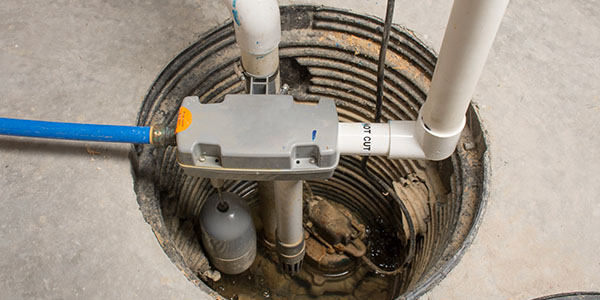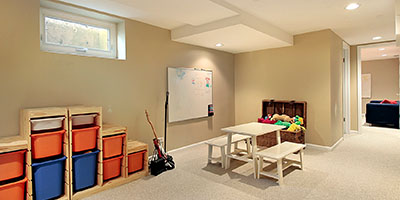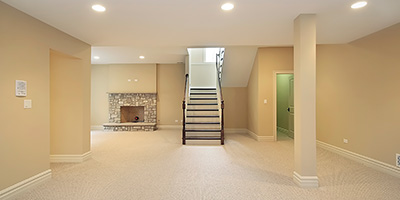How to Fix Leaking Basement Walls

Stop Basement Leaks in Their Cracks
There are few things worse for a homeowner than finding water in the basement, especially when it’s not entirely clear where it’s coming from. Fortunately, water seeping through your basement walls isn’t always a cause for alarm.
There are a number of potential causes for basement leaks, some of which have easy and relatively inexpensive solutions.
Use these steps below to locate your leak and determine the best fix for your “weeping” walls.
How to Locate the Source of Your Basement Leak
As soon as you notice wet spots on your basement floor or wall, investigate the area around it to see if there are any obvious sources.
“Signs of a basement water problem include small streams of water, damp walls, and puddling on the floor. The most common way that water enters a basement is through the foundation wall-floor joint,” says Mallory Finch, marketing coordinator at Baker’s Waterproofing & Foundation Repair.
The wall-floor joint, also known as a cove joint, is one of the most common culprits of basement leaks due to the gap between the wall and floor. As the amount of groundwater builds up, such as during a heavy rainstorm, more pressure is placed on the joint, allowing water to seep in.
Apart from wall-floor joints, here are a few other common sources of basement leaks:
- The tops of your walls: Water can seep over the top of your basement walls when the ground surrounding your home is level or sloped towards your home.
- Wall cracks: Cracks in the wall are one of the most serious causes of basement leaks and often become apparent when it rains. These are fairly noticeable in unfinished basements, but in unfinished basements you’ll have to inspect the outside of the foundation for cracks that run through the wall.

"If it’s a finished basement, we look outside and we look at those areas above grade. If there’s a crack in the wall, then that crack goes all the way down. In that case, we open up the wall and repair it."
Richard Comeras, Founder, A-1 Foundation Crack Repair
- Floor cracks: As with wall cracks, cracks in your basement floor can also be a sign of a serious problem. Cracks smaller than an 1/8 of an inch wide are normal, but anything wider should be sealed.
- Tie rod holes: More common in older homes, these holes appear in poured concrete foundations where tie rods were used to hold wood planks together. Luckily, plugging these holes is a quick and easy repair.
- Window wells: The wells outside your basement windows may let water in when there’s insufficient drainage around your property or when your gutters aren’t working properly.
- Honeycombs: Poorly mixed concrete can sometimes create air pockets within basement walls, resulting in “honeycomb” marks along the wall. These bubbly patches are usually a minor problem and can be sealed up.
- Leaking pipes: Drain pipes are another possible culprit for basement leaks. Check your ceiling and walls for stains or mold.
Is the water rising? Learn what to do when your basement floods!
How to Fix Minor Basement Wall Leaks
Stopping a basement leak can be a simple task, as long as you know that the problem isn’t more serious. Here are a few relatively easy DIY solutions you can use to fix a leaky basement from the inside and outside:
- Replace Window Wells: Replacing old or rusted window wells will give water one less possible point of entry and keep the soil away from your window openings.
- Clean Gutters & Adjust Spouts: “Clean your gutters and extend downspouts to keep roof water far away from the foundation. You won’t want to rely on this alone to keep your basement dry,” Finch says.
- Install a Dehumidifier: A dehumidifier won’t stop basement leaks, but it will remove any excess moisture from the air.
- Regrade Your Soil: Regrading the soil surrounding your foundation will help divert ground and surface water downhill, instead of into your basement. Use this quick how-to guide to determine the slope of your yard, then either call a landscaper or adjust the slope yourself using a skid steer loader and a garden tiller.
- Plug Tie Rod Holes: If you’re certain your leak is coming from the tie rod holes in your wall, all you need to do is plug them using a compressed swell plug. WikiHow has an in-depth article that explains how to install these yourself.
How Much Does It Cost to Repair a Leaking Basement Wall?
The cost to fix a basement wall varies based on the complexity of the problem. The most minor repair jobs cost under $1,000, while the most comprehensive repairs can carry a price tag as high as $10,000.
Water damage repairs not in the budget? Get ahead of it!
Read on for 5 ways to protect your home from water damage.

Call a Professional for More Serious Issues
If your basement wall is leaking due to something more complex, such as a large crack in the foundation, call a professional waterproofing contractor to explore potential solutions.

Pro Tip: Vet Your Contractor Beforehand
"We recommend that you research each contractor that you work with. Check their online reviews, ask for references, and check out the repair solutions on their website and how they compare to other waterproofing contractors."
Mallory Finch, Marketing Coordinator, Baker’s Waterproofing & Foundation Repair
There are a number of fixes that your contractor may recommend, including:
- Waterproofing Membranes: Your contractor may recommend installing a waterproof coating or membrane on either side of your foundation. According to Finch, this “helps prevent moisture and humidity from passing through. This will also improve the appearance of damp, stained, chalky or flaky walls.”
- Exterior French Drain: Exterior French drains redirect surface and groundwater away from a basement. However, these drains are difficult to install with already-built houses as it requires digging up the perimeter of the home and working around utility lines.
- Interior Drain and Sump Pump: A more permanent solution for chronic leaks is to install interior drains under your basement floor. These drainage systems are often paired with a sump pump that pumps the water out of your basement.
These solutions for basement seepage involve more time and money, but they all offer long-term fixes for weeping walls and other basement leaks. A good contractor will walk you through the project beforehand and answer any questions you have regarding costs and timing.
No matter how frustrating the repair process gets, remember that afterwards you’ll have a nice dry basement to enjoy.



